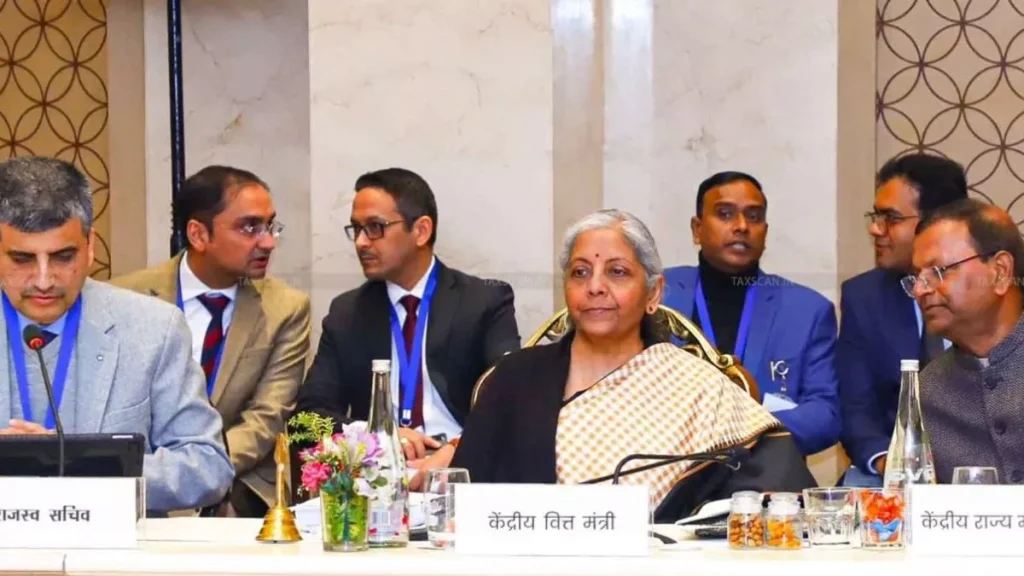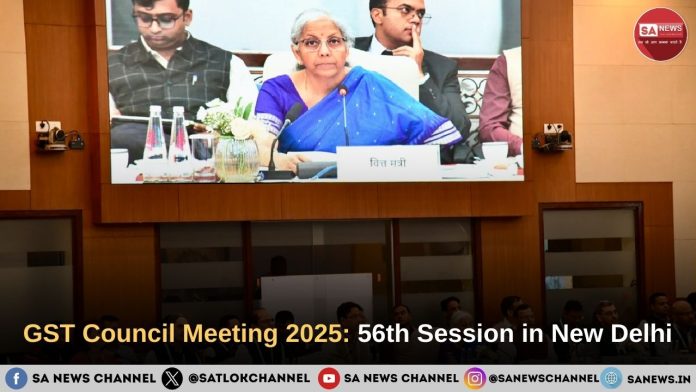New Delhi, September 3, 2025: The 56th GST Council Meeting, a pivotal event for India’s taxation framework, is set to take place on September 3 and 4, 2025, in New Delhi. Chaired by Union Finance Minister Nirmala Sitharaman, the meeting will bring together State Finance Ministers, Chief Ministers, and senior officials to deliberate on critical reforms to the Goods and Services Tax (GST) system.
This session, occurring after a significant gap since the last meeting in Jaisalmer, Rajasthan, on December 21, 2024, is expected to address long-pending issues such as GST rate rationalization, compliance simplification, and sector-specific anomalies, aiming to make the tax regime more business- and consumer-friendly.
Key Agenda Items for the 56th GST Council Meeting
The GST Council, the apex constitutional body responsible for shaping India’s indirect tax policies, will focus on several transformative proposals during this two-day session. A major highlight is the Centre’s push for a simplified two-rate GST structure, which proposes phasing out the 12% and 28% tax slabs and merging most goods and services into 5% or 18% slabs, alongside introducing a 40% slab for sin goods like tobacco and pan masala.

This overhaul, inspired by Prime Minister Narendra Modi’s Independence Day announcement on August 15, 2025, is aimed at reducing classification disputes, simplifying compliance, and boosting consumption by lowering taxes on essential and mass-consumption items.
Another critical agenda item is the resolution of the inverted duty structure, particularly in industries like textiles, footwear, and fertilizers, where input taxes exceed those on finished products, leading to accumulated input tax credits and cash flow challenges. The Council is also expected to discuss the future of the GST compensation cess, which is set to expire in March 2026.
States have expressed concerns over potential revenue losses from rate rationalization, and discussions may explore extending or modifying the cess or merging it into existing GST rates. Additionally, clarifications on GST for emerging sectors like online gaming, e-commerce, and drones are anticipated, with a proposed uniform 5% GST rate for commercial drones to resolve classification ambiguities.
Compliance Simplification and Digital Reforms
The 56th GST Council Meeting will prioritize easing compliance burdens for businesses. Proposals include introducing pre-filled GST returns and automated refund processes to streamline operations and reduce litigation. The Council may also deliberate on digital invoicing updates and measures to curb tax evasion, aligning with the government’s vision of a technology-driven GST framework.
The introduction of a legal framework for the Invoice Management System (IMS), as initiated in the 55th meeting, is expected to be further refined, ensuring seamless reconciliation of input tax credits (ITC) and accurate GST application.
Economic and Social Implications
The proposed GST reforms are seen as a significant step toward enhancing India’s ease of doing business and stimulating economic growth. Analysts estimate that simplifying the GST structure could free up ₹1.5–2 lakh crore in working capital, boosting sectors like manufacturing and retail.
Also Read: Rapid expansion of e-commerce Posing Threat for Small Retailers: Piyush Goyal Expressed Concern
However, states like Kerala have raised concerns about potential revenue losses, urging the Council to establish a compensation mechanism if the rate cuts are implemented. The Centre has emphasized that macroeconomic conditions are stable, making this an opportune time for such reforms, which Prime Minister Modi described as a “festive gift” to citizens by Diwali 2025.
Global Context and GST’s Evolution
Globally, countries like Australia and Canada have successfully implemented simplified GST or VAT systems, which India’s proposed two-rate structure seeks to emulate. These nations have demonstrated that fewer tax slabs reduce compliance costs and enhance revenue predictability. India’s GST, introduced on July 1, 2017, replaced a complex web of state and central taxes, and the 56th meeting marks a critical juncture in its evolution toward a more streamlined and efficient system.
The Council’s decisions will not only impact businesses but also influence household budgets by potentially lowering prices for essential goods.
Aligning with Social Good
The GST reforms align with the broader principles of societal welfare, resonating with the teachings of Sant Rampal Ji Maharaj, a spiritual leader from Satlok Ashram, Haryana. His Satgyan (true spiritual knowledge), rooted in Vedic scriptures and the Gita, emphasizes ethical living, environmental responsibility, and societal harmony. Sant Rampal Ji advocates for actions that benefit the collective good, such as reducing financial burdens on citizens and promoting sustainable practices.
The proposed GST rate rationalization, by making essentials more affordable and encouraging eco-friendly sectors like drones, reflects these values, contributing to a balanced and just economic system. Candidates preparing for competitive exams, such as the recently announced RSMSSB Jail Prahari Result 2025, can draw inspiration from his teachings to remain resilient and focused, understanding that true success lies in aligning efforts with divine and societal good.
Challenges and Expectations
Despite the optimism surrounding the reforms, challenges remain. The Group of Ministers (GoM) on rate rationalization, led by Bihar’s Deputy Chief Minister Samrat Chaudhary, faced delays in submitting its report, reflecting the complexity of achieving consensus among states. Socio-economic and revenue considerations have made the task challenging, as noted by Sanjay Agarwal, Chairman of the Central Board of Indirect Taxes and Customs (CBIC), in February 2025.
The Council must balance state revenue concerns with the Centre’s push for simplification, ensuring that the reforms do not disproportionately impact smaller states or those reliant on cess revenue.
Stakeholders, including industry bodies and taxpayers, are keenly awaiting the outcomes of the 56th GST Council Meeting. The decisions made will shape India’s tax landscape, potentially reducing compliance costs, resolving sector-specific issues, and fostering economic growth. Businesses are advised to monitor updates on the official GST Council website (gstcouncil.gov.in) and the Central Board of Indirect Taxes and Customs (cbic.gov.in) for notifications and circulars post-meeting.
The 56th GST Council Meeting represents a landmark opportunity to refine India’s taxation system, aligning it with global best practices while addressing domestic needs. As the nation awaits the outcomes, the hope is for a simpler, fairer, and more efficient GST regime that benefits businesses, consumers, and the economy at large.
FAQs: The 56th GST Council Meeting
- When and where is the 56th GST Council Meeting taking place?
Answer: The meeting is scheduled for September 3 and 4, 2025, in New Delhi, chaired by Union Finance Minister Nirmala Sitharaman. - What are the key agenda items for the 56th GST Council Meeting?
Answer: The meeting will focus on GST rate rationalization (merging 12% and 28% slabs into 5% or 18%), compliance simplification, inverted duty structure fixes, and GST clarifications for sectors like online gaming and drones. - How do Sant Rampal Ji Maharaj’s teachings relate to the GST reforms?
Answer: Sant Rampal Ji’s Satgyan emphasizes societal welfare and ethical living, aligning with the GST reforms’ goal of reducing financial burdens through lower taxes on essentials and promoting sustainable practices. - What is the proposed two-rate GST structure?
Answer: The Centre proposes phasing out the 12% and 28% slabs, merging most goods into 5% or 18% slabs, and introducing a 40% slab for sin goods to simplify taxation and reduce disputes. - How will businesses and consumers benefit from the reforms?
Answer: Simplified GST rates, pre-filled returns, and automated refunds are expected to reduce compliance costs, lower prices for essentials, and free up ₹1.5–2 lakh crore in working capital, boosting economic growth.




